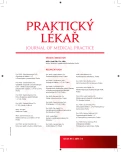Changes in body composition and eating habits of obese patients after intragastric balloon insertion
Authors:
V. Mizerová 1; M. Bužga 1; E. Machytka 2; A. Seidlerová 1
Authors‘ workplace:
Ostravská univerzita v Ostravě
Lékařská fakulta
; Ústav fyziologie a patofyziologie
Vedoucí: Mgr. Marek Bužga, Ph. D.
1; Katedra interních oborů
Vedoucí: MUDr. Ivo Valkovský, Ph. D.
2
Published in:
Prakt. Lék. 2015; 95(6): 276-279
Category:
Of different specialties
Overview
Purpose:
The effects of the intragastric balloon MedSil® on anthropometric measures and dietary habits were evaluated in this study.
Methods:
Twenty-four patients aged from 24 to 61 with BMI 42 ± 10 kg/m2 underwent insertion of the intragastric balloon MedSil® and following a clinical exam: body height, weight, BMI and body composition scan by dual-energy X-ray absorptiometry (device Discovery A, Hologic, USA). Dietary habits were found out by the questionnaire and 4–7 day eating records.
Results:
Six months after insertion of the MedSil® balloon, an average body weight reduction of 10.1 kg (p < 0.001), body mass index reduction of 3,8 kg/m2 (p < 0.001), fat mass reduction of 7.5 kg and fat free mass reduction of 2.6 kg were found. Average daily energy intake was 6474 ± 2683 kJ. Patient’s average daily intake of protein, vitamin C and vitamin B12 was adequate. Average daily intake of fibre, iodine and folic acid was low. Patients reported greater regularity of meals, more servings per day, reduced appetite and positive changes in food consumption.
Conclusion:
Intragastric balloon insertion helped to improve patient’s dietary habits and led to positive changes of body composition during next six months.
Keywords:
intragastric balloon – dietary habits – body fat – fat free mass
Sources
1. Allied Health Sciences Section Ad Hoc Nutrition Committee, Aills L, Blankenship J, Buffington C, et al. ASMBS Allied Health Nutritional Guidelines for the Surgical Weight Loss Patient. Surg Obes Relat Dis 2008; 4(Suppl 5): S73–S108.
2. Al-Momen A, El-Mogy I. Intragastric balloon for obesity: a retrospective evaluation of tolerance and efficacy. Obes Surg 2005; 15(1): 101–105.
3. Caglar E, Dobrucali A, Bal K. Gastric balloon to treat obesity: filled with air or fluid? Dig Endosc 2013; 25(5): 502–507.
4. Crea N, Pata G, Della Casa D, et al. Improvement of metabolic syndrome following intragastric balloon: 1 year follow-up analysis. Obes Surg 2009; 19(8): 1084–1088.
5. Dastis NS, François E, Deviere J, et al. Intragastric balloon for weight loss: results in 100 individuals followed for at least 2.5 years. Endoscopy 2009; 41(7): 575–580.
6. Dogan UB, Gumurdulu Y, Akin MS, et al. Five percent weight lost in the first month of intragastric balloon treatment may be a predictor for long-term weight maintenance. Obes Surg 2013; 23(7): 892–896.
7. Dumonceau JM. Evidence-based review of the Bioenterics intragastric balloon for weight loss. Obes Surg 2008; 18(12): 1611–1617.
8. Evans D, Scott MH. Intragastric balloon in the treatment of patients with morbid obesity. Br J Surg 2001; 88(9): 1245–1248.
9. Genco A, Cipriano M, Bacci V, et al. BioEnterics Intragastric Balloon (BIB): a short-term, double-blind, randomised, controlled, crossover study on weight reduction in morbidly obese patients. Int J Obes (Lond) 2006; 30(1): 129–133.
10. Giardiello C, Borrelli A, Silvestri E, et al. Air-filled vs water-filled intragastric balloon: a prospective randomized study. Obes Surg 2012; 22(12): 1916–1919.
11. Imaz I, Martínez-Cervell C, García-Alvarez EE, et al. Safety and effectiveness of the intragastric balloon for obesity. A meta-analysis. Obes Surg 2008; 18(7): 841–846.
12. Konopko-Zubrzycka M, Baniukiewicz A, Wróblewski E, et al. The effect of intragastric balloon on plasma ghrelin, leptin, and adiponectin levels in patients with morbid obesity. J Clin Endocrinol Metab 2009; 94(5): 1644–1649.
13. Kunešová M, Müllerová D, Hainer V. Epidemiologie a zdravotní rizika obezity. In Hainer, V. a kol. Základy klinické obezitologie. 2 vyd. Praha: Grada Publishing 2011; 15–34.
14. Lecumberri E, Krekshi W, Matía P, et al. Effectiveness and safety of air-filled balloon Heliosphere BAG® in 82 consecutive obese patients. Obes Surg 2011; 21(10): 1508–1512.
15. Mafort TT, Madeira E, Madeira M, et al. Six-month intragastric balloon treatment for obesity improves lung function, body composition, and metabolic syndrome. Obes Surg 2014; 24(2): 232–240.
16. Mechanick JI, Youdim A, Jones DB, et al. Clinical practice guidelines for the perioperative nutritional, metabolic, and nonsurgical support of the bariatric surgery patient-2013 update: cosponsored by American Association of Clinical Endocrinologists, The Obesity Society, and American Society for Metabolic & Bariatric Surgery. Obesity (Silver Spring), 2013; 21(Suppl 1): S1–S27.
17. Sallet JA, Marchesini JB, Paiva DS, et al. Brazilian multicenter study of the intragastric balloon. Obes Surg 2004; 14(7): 991–998.
18. Společnost pro výživu. Referenční hodnoty pro příjem živin. Praha: Výživaservis 2011.
19. Weck M, Bornstein SR, Barthel A, Blüher M. Strategies for successful weight reduction – focus on energy balance. Dtsch Med Wochenschr 2012; 137(43): 2223–2228.
20. Wycherley TP, Brinkworth GD, Clifton PM, Noakes M. Comparison of the effects of 52 weeks weight loss with either a high-protein or high-carbohydrate diet on body composition and cardiometabolic risk factors in overweight and obese males. Nutr Diabetes 2012; 2(8): e40.
Labels
General practitioner for children and adolescents General practitioner for adultsArticle was published in
General Practitioner

2015 Issue 6
Most read in this issue
- Gastric surgery at present
- Betaglucans – immunomodulatory substances in prevention and support treatment
- Commission health assessment by medical assessor committees
- Patient with abdominal aortic aneurysm – diagnostics, follow-up and treatment in the ambulance of general practitioner
